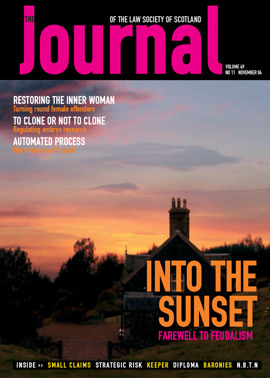Website reviews
Scottish Executive
The Scottish Executive’s website is very good. It contains a number of different sections, and is also organised into 19 different topics which broadly coincide with the Executive’s areas of activity, e.g. transport.
The main areas I regularly find useful are publications and consultations. The publications section produces online just about everything with the Executive’s stamp on it (a quite enormous amount). This includes annual statistics and reports, statutory guidance and codes of practice. It is too cynical to suggest that it is a clever way to transfer publication costs to the reader. It is extremely useful to be able to download these publications so quickly and easily. In addition, the Scottish Executive will send you a paper copy of most things, if you ask nicely, although some documents are only available online. Most publications are made available in both html and pdf, increasing accessibility.
The consultation section includes a formal public consultation for most new pieces of legislation (often more than once) and for wider issues which may, in due course, develop into legislation. This section allows you not only to read the papers, but to respond to them electronically, if you wish.
The various other sections include up-to-date news; campaign micro-sites for e.g. drugs information, public transport, healthy diet etc; and departmental information. The website is as accessible as you would expect for a government website. Also, it has recently acquired some whistles and bells in the form of RSS feeds.
RSS is a sort of news reader which can be installed onto your computer’s desktop. Then whenever you are online and there is new material from the Executive’s website (or indeed elsewhere) that you have requested, it appears in your reader. So you could, for example, request that your RSS news aggregator receive notification of new justice publications, or agriculture news, or whatever. For more technical information, go to your favourite search engine and type in “rss”.
The website can be difficult to navigate. This is inevitable to an extent, due to its size. However, the search function could work a lot better, and the thematic organisation of the site is not entirely consistent, making it quite difficult to find particular information, which can be frustrating.
Scottish Parliament
Closely linked (if you’ll excuse the pun) to the Executive’s website is the Scottish Parliament’s, constructed at a far lower cost than the notorious Parliament building itself, but no less impressive for all that.
There is a tremendous amount of information on this site. For legislation, the best page to start with is Bills. This allows you to track the progress of bills (Executive or private member’s), from the first draft, though the three readings and committees, to the final version as passed. Unfortunately, you have to transfer to HMSO (www.hmso.gov.uk) to read the Act post-Royal Assent. For an insight into the changes as the bill progresses, the website allows you access to the records of the various committee proceedings and the main chamber. If you are really keen, you can watch these live on www.holyrood.tv .
You can check up on motions and amendments made, parliamentary answers, and parliamentary procedure. You can also look up your own MSPs, what they have on the register of interests and how to contact them.
The website even allows you to influence the lawmaking process. Through the public petitions committee pages, you can access the guidance on submission of petitions. These are considered by the committee and some end up as legislative proposals. You can view petitions which are currently open for signature and sign online those you support. There is also a style petition which you can use to influence the lawmakers.
Scotland Office
It is commonly supposed that the Scotland Office has very little left to do. What it does have (among other things) is this site. It is very attractively set out, and easy to navigate. Of particular interest are two sections. The guidance notes to the devolution settlement provide a historical background and a legal explanation of the current arrangements. The history of Scottish representation in government from the Union of the Crowns to post-devolution is also interesting and engaging.
OpenScotland
OpenScotland is in fact a sub-section of the Scottish Executive’s site with its own URL (website address). The 21st Century Government Unit of the Executive aims to provide better access to, and improved delivery of public services, and to make sure that people in Scotland have the skills, access and awareness to allow use of computers and the web in their daily lives. This website details the Unit’s activities.
The Executive’s objective is for all public services which can be delivered electronically to be online by 2005. You can find details of progress here.
In this issue
- Drafting consumer contracts
- Virtual firms: transactional learning on the web
- Ignorantia juris: it's all Greek to me
- Sheriff Court Rules Council consultation paper
- The Clinical Trials Directive - a summary
- Guarding the inner sanctum
- Neighbours in the global village
- Family law: is it the path for you?
- From sunset to sunrise
- What next for conveyancing?
- An ethical minefield
- Shredding the evidence
- Robbing the poor?
- Our dynamic profession
- A wider angle
- Keep the eye on the ball
- A rough guide to becoming a partner
- Rediscovering hope
- Sharpen your pencils
- Significant other
- Too far or not enough?
- Chipping away the infringers?
- View from Holyrood
- Website reviews
- Book reviews
- The Registers and the Appointed Day
- Feudal law: not just a relic
- Birth of a register






